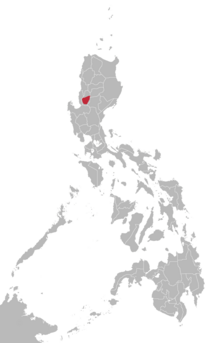Ibaloi language
| Ibaloi | |
|---|---|
| Ibaloy | |
| Ivadoy | |
| Region | Luzon, Philippines |
| Ethnicity | Ibaloi people |
Native speakers | (110,000 cited 1990 census)[1] |
Language family | Austronesian
|
| Language codes | |
| ISO 639-3 | ibl |
| Glottolog | ibal1244 |
 Area where Ibaloi is spoken according to Ethnologue | |
The Ibaloi language (ësël ivadoy, /əsəl ivaˈdoj/) belongs to the Malayo-Polynesian branch of the Austronesian languages family. It is closely related to the Pangasinan language, which is spoken primarily in central and southern Benguet, and western Nueva Vizcaya. Its dialects include Daklan, Kabayan, and Bokod.
Ibaloi phonemes are similar to those found in other Philippine languages with a few exceptions. Many variants of the Ibaloi tongue have naturally occurring /f/, /dʒ/ and /v/, as in sifa (interrogative who), ibjag (to lose one's grip on something or someone, to let go) and devit (a traditional wrap-around skirt). /ʃ/ is also commonly heard in the La Trinidad valley and nearby areas, as in xima (a particle usually equivalent to the prepositions in, on, or to depending on the sentence construction), but may be occasionally heard as /tʃ/ in some communities.[2]
References[]
- ^ Ibaloi at Ethnologue (18th ed., 2015) (subscription required)
- ^ http://www.inibaloi.com/ibl/working-orthography
- A handy guidebook to the Ibaloi language. Baguio City, Philippines: Tebtebba Foundation, 2010.
External links[]
Languages of the Philippines | |||||||||||||||||||||||||||||||||||
|---|---|---|---|---|---|---|---|---|---|---|---|---|---|---|---|---|---|---|---|---|---|---|---|---|---|---|---|---|---|---|---|---|---|---|---|
| Official languages |
| ||||||||||||||||||||||||||||||||||
| Regional languages |
| ||||||||||||||||||||||||||||||||||
| Indigenous languages (by region) |
| ||||||||||||||||||||||||||||||||||
| Immigrant languages |
| ||||||||||||||||||||||||||||||||||
| Sign languages |
| ||||||||||||||||||||||||||||||||||
| Historical languages |
| ||||||||||||||||||||||||||||||||||
Philippine languages | |||||||||||||||||||||||||
|---|---|---|---|---|---|---|---|---|---|---|---|---|---|---|---|---|---|---|---|---|---|---|---|---|---|
| Batanic (Bashiic) |
| ||||||||||||||||||||||||
| Northern Luzon |
| ||||||||||||||||||||||||
| Central Luzon |
| ||||||||||||||||||||||||
| Northern Mindoro | |||||||||||||||||||||||||
| Greater Central Philippine |
| ||||||||||||||||||||||||
| Kalamian | |||||||||||||||||||||||||
| Bilic | |||||||||||||||||||||||||
| Sangiric |
| ||||||||||||||||||||||||
| Minahasan |
| ||||||||||||||||||||||||
| Other branches |
| ||||||||||||||||||||||||
| Reconstructed | Proto-Philippine † | ||||||||||||||||||||||||
| |||||||||||||||||||||||||
Austronesian languages | |||||||||||||||||||||||||||||||||||||||||||||||||||||||||||||||||||||||||||||||||||||||||||||||||||||||||||||||||||||||||||||||||||||||||||||||||||||||||||||||||||||||||||||||||||||||||||||||||||||||||||||||||||||||||||||||||||||||||||||||||||||||||||||||||||||||||||||||||||||||||||||||||||||||||||||||||||||||||||||||||||||||||||||||||||||||||||||||||||||||||||||||||||||||||||||||||||||||||||||||||||||||||||||||||||||||||||
|---|---|---|---|---|---|---|---|---|---|---|---|---|---|---|---|---|---|---|---|---|---|---|---|---|---|---|---|---|---|---|---|---|---|---|---|---|---|---|---|---|---|---|---|---|---|---|---|---|---|---|---|---|---|---|---|---|---|---|---|---|---|---|---|---|---|---|---|---|---|---|---|---|---|---|---|---|---|---|---|---|---|---|---|---|---|---|---|---|---|---|---|---|---|---|---|---|---|---|---|---|---|---|---|---|---|---|---|---|---|---|---|---|---|---|---|---|---|---|---|---|---|---|---|---|---|---|---|---|---|---|---|---|---|---|---|---|---|---|---|---|---|---|---|---|---|---|---|---|---|---|---|---|---|---|---|---|---|---|---|---|---|---|---|---|---|---|---|---|---|---|---|---|---|---|---|---|---|---|---|---|---|---|---|---|---|---|---|---|---|---|---|---|---|---|---|---|---|---|---|---|---|---|---|---|---|---|---|---|---|---|---|---|---|---|---|---|---|---|---|---|---|---|---|---|---|---|---|---|---|---|---|---|---|---|---|---|---|---|---|---|---|---|---|---|---|---|---|---|---|---|---|---|---|---|---|---|---|---|---|---|---|---|---|---|---|---|---|---|---|---|---|---|---|---|---|---|---|---|---|---|---|---|---|---|---|---|---|---|---|---|---|---|---|---|---|---|---|---|---|---|---|---|---|---|---|---|---|---|---|---|---|---|---|---|---|---|---|---|---|---|---|---|---|---|---|---|---|---|---|---|---|---|---|---|---|---|---|---|---|---|---|---|---|---|---|---|---|---|---|---|---|---|---|---|---|---|---|---|---|---|---|---|---|---|---|---|---|---|---|---|---|---|---|---|---|---|---|---|---|---|---|---|---|---|---|---|---|---|---|---|---|---|---|---|---|---|---|---|---|---|---|---|---|---|---|---|---|---|---|---|---|---|---|---|---|---|---|---|---|---|---|---|---|---|---|---|---|
| |||||||||||||||||||||||||||||||||||||||||||||||||||||||||||||||||||||||||||||||||||||||||||||||||||||||||||||||||||||||||||||||||||||||||||||||||||||||||||||||||||||||||||||||||||||||||||||||||||||||||||||||||||||||||||||||||||||||||||||||||||||||||||||||||||||||||||||||||||||||||||||||||||||||||||||||||||||||||||||||||||||||||||||||||||||||||||||||||||||||||||||||||||||||||||||||||||||||||||||||||||||||||||||||||||||||||||
| |||||||||||||||||||||||||||||||||||||||||||||||||||||||||||||||||||||||||||||||||||||||||||||||||||||||||||||||||||||||||||||||||||||||||||||||||||||||||||||||||||||||||||||||||||||||||||||||||||||||||||||||||||||||||||||||||||||||||||||||||||||||||||||||||||||||||||||||||||||||||||||||||||||||||||||||||||||||||||||||||||||||||||||||||||||||||||||||||||||||||||||||||||||||||||||||||||||||||||||||||||||||||||||||||||||||||||
| |||||||||||||||||||||||||||||||||||||||||||||||||||||||||||||||||||||||||||||||||||||||||||||||||||||||||||||||||||||||||||||||||||||||||||||||||||||||||||||||||||||||||||||||||||||||||||||||||||||||||||||||||||||||||||||||||||||||||||||||||||||||||||||||||||||||||||||||||||||||||||||||||||||||||||||||||||||||||||||||||||||||||||||||||||||||||||||||||||||||||||||||||||||||||||||||||||||||||||||||||||||||||||||||||||||||||||
This article about Philippine languages is a stub. You can help Wikipedia by . |
- v
- t
- Languages of Benguet
- Languages of Nueva Vizcaya
- South–Central Cordilleran languages
- Philippine language stubs
- Pages containing links to subscription-only content
- Language articles citing Ethnologue 18
- Articles with short description
- Short description is different from Wikidata
- Language articles with old Ethnologue 18 speaker data
- All stub articles